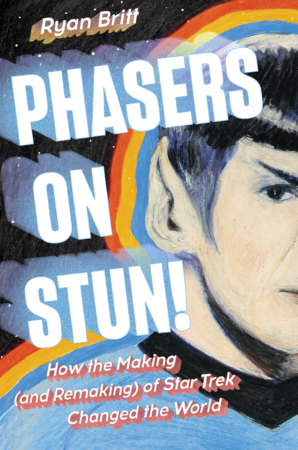Every day, you like to go where no one has gone before.
To the supermarket, to your bedroom down the hall, to your desk or workstation, even if you were just there, you like to make your journey a little bit different. Change is good, and in the new book “Phasers on Stun” by Ryan Britt, you’ll see how one iconic television show altered our entertainment.
Gene Roddenberry was already experienced in TV writing. He had been working on a crime-drama series that he called “very bad shows” but that was fine. The crime drama wasn’t really his focus. No, his heart was on a science fiction series he thought could “reinvent what an episodic TV show could be.” A bit of stability in his work was icing on the cake.
His first episode of this new show was loaded with issues, however. Majel Barrett, who would eventually become his wife, was his mistress then, says Britt, and casting her in what was a very major role was a mistake — not because of Barrett but because the character itself was all wrong and had to be almost completely revised.
The network, NBC, gave him a choice-no-choice on that.
What followed, beginning with the show’s next (second) episode, launched an almost-fifty-year phenomenon that included multiple movies, multiple spin-offs, a cartoon series, an anthology series, and a conference held annually. To accomplish that, Roddenberry did what no man had done before: he invited science fiction writers to submit their ideas; some were hired to write screenplays for their stories. Then he insisted on adding a Black female in a recurring role, as well as a man of Asian descent and the son of Russian immigrants.
Roddenberry’s work left a lingering impact on NASA. It had a small part in saving whales and in making fan conventions the huge events they are today.
And yet, twenty years after Star Trek appeared on television, its creator was ready to walk away from it all for good…
Judging solely by its subtitle “Phasers on Stun” is a bit of a disappointment. Author Ryan Britt names a few national impacts left by the show and a handful of much-needed changes to the way series TV was produced, but… the world? Eh, not so much.
But Trekkers won’t care one bit. Nor will Trekkies, the difference of which is high among the subjects Britt writes about, in a book that’s like combat to a Klingon. His knowledge and his insider’s sense springs from a lifelong obsession with the show and a career spent writing about it. Not only does that lead Britt to transport readers with his acumen, but he does so with tidbits of interesting information that are as abundant as Tribbles on a bridge.
This is good for fans of all levels — even if, dang it, you’re a doctor, not a, well, whatever. If you love the shows, movies, and the entire cast, “Phasers on Stun” is the next book you want to read. Missing it would be highly illogical.
“Phasers on Stun: How the Making (and Remaking) of Star Trek Changed the World” by Ryan Britt
c.2022, Plume
$28.00
400 pages




